これで、回路図のキャプチャ(描画)を開始する準備が整いました。
コンポーネントの配置
メインページ: コンポーネントの検索と配置
Altium Designerがワークスペースに接続されている場合、Componentsパネルには、このワークスペースからプロジェクト設計で使用できるすべてのコンポーネントがリストされます。このようなコンポーネントについて、Componentsパネルは、文字列ベースの検索、ファセット検索、またはその両方の組み合わせ、さらにManufacturer Part Searchパネルと同じ検索機能をサポートしており、Find Similar Components機能も利用できます。
Componentsパネルを使用すると、製造元部品検索パネルから取得したコンポーネントがマルチバイブレータ回路に配置されます。コンポーネントを配置したら、回路図は下の画像のようになります。
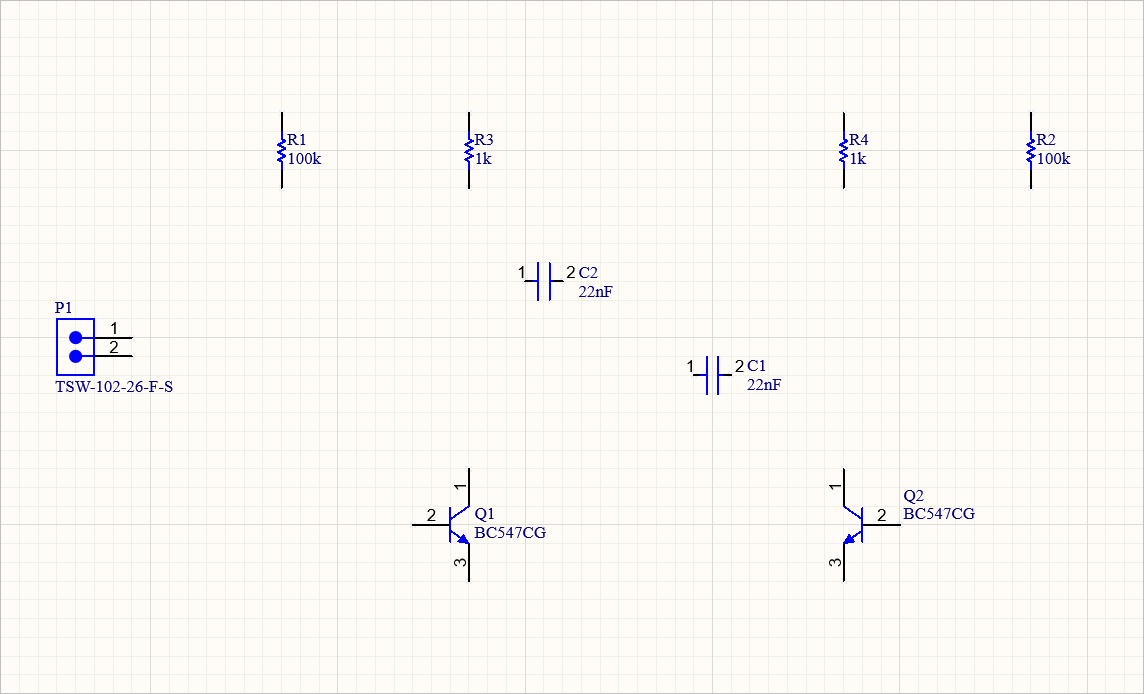
すべてのコンポーネントが配置され、配線の準備ができました。
-
コンポーネントは、各コンポーネントのピンに配線するための十分なスペースがあるように配置されていることに注意してください。これは重要です。なぜなら、ピンの下を横切って配線を配置し、それを超えるピンに到達しようとすると、両方のピンが配線に接続されてしまうからです。必要に応じて、配置後にコンポーネントの位置を変更できます。
-
Componentsパネルは、通常モードとコンパクトモードの2つのモードで操作できます。このチュートリアルでは、通常モードで表示され、説明されているパネルが示されています。パネルを広げて通常モードで表示されるようにしてください。パネルが通常モードの場合、パネルの右上にあるボタンが  として表示されます。コンパクトモードの場合、コントロールが再配置されるため、ここで示され、説明されているものとは正確には一致しない場合があります。
として表示されます。コンパクトモードの場合、コントロールが再配置されるため、ここで示され、説明されているものとは正確には一致しない場合があります。
オブジェクトの配置と編集に関する注意
-
オブジェクト(コンポーネントなど)がカーソル上で浮いている間に、次の操作ができます:
-
配置前にオブジェクトのプロパティを編集するには、編集プロセスを一時停止し、Tab を押してプロパティパネルを表示します。最も一般的に編集されるフィールドがハイライト表示され、編集の準備ができます。編集プロセスが一時停止しているため、カーソルを使用するか(またはキーボードでTabを押して)、パネル内の別のフィールドに移動できます。入力された値はデフォルトになります。コンポーネントの場合、デザイネータは同じプレフィックスがある場合に自動的にインクリメントされます。編集が完了したら、デザインスペース内の一時停止ボタン( )をクリックしてオブジェクト配置(
)をクリックしてオブジェクト配置( )に戻ります。
)に戻ります。
-
配置中にオブジェクトのプロパティを編集することもできますが、オブジェクトが配置された後に編集を行うこともできます。これを行うには、配置されたオブジェクトをダブルクリックして選択し、Propertiesパネルを開きます。
-
複数のオブジェクトも選択できます。 Shift+Clickを使用してオブジェクトを順番に選択するか、選択範囲(クリック、ホールド&ドラッグ)を使用して、選択範囲内にあるすべてのオブジェクトを選択します。
-
Propertiesパネルは、同時に複数の選択されたオブジェクトを編集することをサポートしています。
-
すべてのオブジェクトがあるプロパティを共有している場合、そのプロパティは編集可能になります。
-
すべてのオブジェクトが同じプロパティ値を共有している場合、その値が表示されます。
-
オブジェクトが同じプロパティを共有しているが異なる値を持っている場合、アスタリスク(*)が表示されます。
-
入力された値または選択されたオプションは、選択されたすべてのオブジェクトに適用されます。
-
オブジェクトの配置中に、デザインスペースの端に触れるとAltium Designerは自動的にパンします。オートパンは、Preferencesダイアログ(デザインスペースの左上にある  ボタンをクリックしてアクセス)のSchematic – Graphical Editing pageページで設定されます。オブジェクトがカーソル上で浮いている間に誤って望まない場所までパンした場合は、
ボタンをクリックしてアクセス)のSchematic – Graphical Editing pageページで設定されます。オブジェクトがカーソル上で浮いている間に誤って望まない場所までパンした場合は、 Ctrl+マウスホイール と 右クリック、ホールド&ドラッグ を使用してズームとパンを行うか、 Ctrl+PgDnを使用してシート全体を再表示します。
-
オブジェクトを再配置するには、カーソルを直接オブジェクトの上に置き、左マウスボタンをクリックして保持し、オブジェクトを新しい位置にドラッグしてからマウスボタンを離します。移動は現在のスナップグリッドに制約され、ステータスバーに表示されます。Gショートカットをいつでも押して、現在のスナップグリッド設定をサイクルします。Gショートカットを押すとサイクルするグリッドは、PreferencesダイアログのSchematic – Gridsページで定義されています。回路を整然と保ち、ピンにワイヤーを接続しやすくするために、コンポーネントを50または100ミルの粗いグリッドに配置することをお勧めします。このチュートリアルのデザインのようなシンプルなデザインの場合、100ミルが良い選択です。
-
キーボードの矢印キーを使用して、選択した回路図オブジェクトまたはオブジェクトのグループを再配置することもできます。オブジェクトを選択してから、矢印キーをCtrlキーを押しながら押します。さらにShiftキーを押すと、現在のスナップグリッドの10倍の距離でオブジェクトを移動できます。
回路図配置&編集テクニックについてもっと学ぶ。
トランジスタの配置

-
メインメニューからView » Fit Documentを選択して、回路図シートがデザインスペースを埋めるようにします。
-
Componentsパネルを開きます。これを行うには、デザインスペースの右下にある ボタンをクリックして、メニューからComponentsを選択します。
ボタンをクリックして、メニューからComponentsを選択します。
-
 ボタンをクリックして Componentsパネルの左上にあるCategoriesペインを開きます。Allエントリを選択して、ワークスペースライブラリにアクセスします。
ボタンをクリックして Componentsパネルの左上にあるCategoriesペインを開きます。Allエントリを選択して、ワークスペースライブラリにアクセスします。
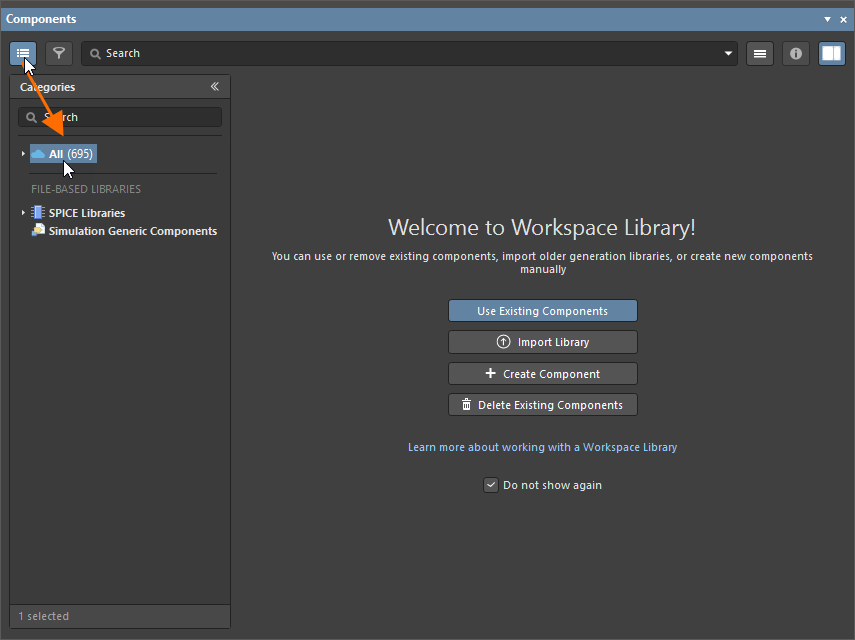
その後、Categoriesペインは、  ボタンをクリックすることで閉じることができます。
ボタンをクリックすることで閉じることができます。
-
 ボタンをクリックしてComponentsパネルの上部にあり、メニューからRefreshを選択して、Manufacturer Part Searchパネルから取得したコンポーネントでパネルの内容を更新します。
ボタンをクリックしてComponentsパネルの上部にあり、メニューからRefreshを選択して、Manufacturer Part Searchパネルから取得したコンポーネントでパネルの内容を更新します。

-
パネルの上部にあるSearchフィールドにtransistor BC547と入力します。検索結果がパネルに表示されます。

-
検索結果グリッドで見つかったトランジスタ(BC547CG)のエントリをクリックして選択します。
-
パネルのDetailsペインを表示するために  ボタンを使用して、選択したコンポーネントの詳細を探索できます。
ボタンを使用して、選択したコンポーネントの詳細を探索できます。

-
パネルの結果グリッドで必要なトランジスタをクリックして選択し、その後  ボタンをDetailsペインでクリックします。カーソルは自動的に回路図シートの範囲内に移動し、トランジスタのシンボルがそれに浮かんだクロスヘアに変わります。これで、コンポーネント配置モードに入ります。カーソルを動かすと、トランジスタもそれについて動きます。
ボタンをDetailsペインでクリックします。カーソルは自動的に回路図シートの範囲内に移動し、トランジスタのシンボルがそれに浮かんだクロスヘアに変わります。これで、コンポーネント配置モードに入ります。カーソルを動かすと、トランジスタもそれについて動きます。
まだトランジスタを配置しないでください!

-
トランジスタがカーソル上に浮いている間に、Tabキーを押してPropertiesパネルを開きます。最もよく使用されるフィールドとして、Designatorフィールドはパネル内で自動的に強調表示され、編集の準備が整います。

-
Q1をDesignatorフィールドに入力し、Commentフィールドの表示制御が可視( として表示)に設定されていることを確認してください。
として表示)に設定されていることを確認してください。
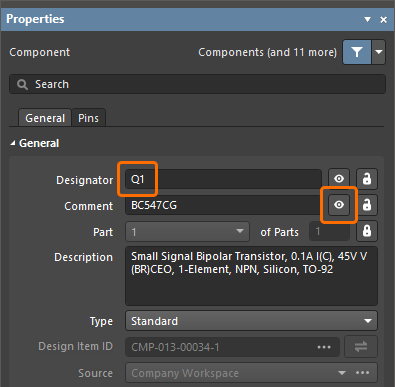
-
他のフィールドはデフォルト値のままにして、設計スペース内の一時停止ボタン( )をクリックして、コンポーネントの配置に戻ります。
)をクリックして、コンポーネントの配置に戻ります。
-
トランジスタのシンボルが付いたカーソルを動かして、トランジスタをシートの中央より少し左に配置します。トランジスタの位置に満足したら、クリックして回路図上に配置します。
配置したコンポーネントの位置や向きを変更する必要がある場合は、クリックしてホールド&ドラッグを使用して、必要な位置に移動します。ドラッグ中にSpacebar、X、およびYキーを使用して、それぞれ回転、水平反転、垂直反転させます。

-
カーソルを動かすと、回路図シート上にトランジスタのコピーが配置され、カーソル上にトランジスタのシンボルを浮かべたままコンポーネント配置モードになります。この機能により、同じコンポーネントの複数のインスタンスを配置できます。
-
2番目のトランジスタを配置する準備ができました。このトランジスタは前のものと同じなので、配置する前に属性を編集する必要はありません。Altium Designerは、同じコンポーネントの複数のインスタンスを配置するときに、コンポーネントのデザイネータを自動的にインクリメントします。この場合、次のトランジスタは自動的にQ2と指定されます。
上に示された回路図を参照すると、Q2がQ1の鏡像として描かれていることがわかります。カーソル上に浮かんでいるトランジスタの向きを水平に反転させるには、キーボードのXキーを押します。
-
カーソルを動かして、コンポーネントをQ1の右側に配置します。
グリッド線を使用してコンポーネントをより正確に配置するには、ズームイン(Ctrl+マウスホイール)してグリッドを表示します。

-
コンポーネントを配置したら、クリックしてQ2を配置します。再び、"保持"しているトランジスタのコピーが回路図上に配置され、次のトランジスタがカーソル上に浮かんで配置の準備ができます。
-
トランジスタが両方とも配置されたので、右クリックするかEscキーを押してコンポーネント配置を終了します。カーソルは標準の矢印に戻ります。
キャパシタの配置
-
Componentsパネルに戻り、パネルのSearchフィールドを使用してcapacitor 22nF 16V 0603を検索します。
-
検索結果グリッドで見つかったキャパシタのエントリ(Capacitor 22nF +/-5% 16V 0603)を選択します。
-
多くの抵抗器やキャパシタには、異なる密度レベルのための複数のフットプリントモデルがあります。DetailsペインのModels領域で、フットプリントプレビューの下にあるAバリエーション(FP-C0603C-CF-IPC_A)を選択します。
このフットプリント選択は、配置中または配置後にプロパティパネルを使用して行うこともできます。

-
 ボタンをDetailsペインでクリックします。
ボタンをDetailsペインでクリックします。
-
キャパシタがカーソル上に浮かんでいる間に、Tabキーを押してPropertiesパネルを開きます。
-
C1をDesignatorフィールドに入力します。
-
パネルのParameters領域にあるShow Moreリンクをクリックして、コンポーネントパラメータの完全なリストを表示します。Valueパラメータの可視性が有効になっていることを確認します。このパラメータの値は、設計スペースのコンポーネントの隣に表示されます。
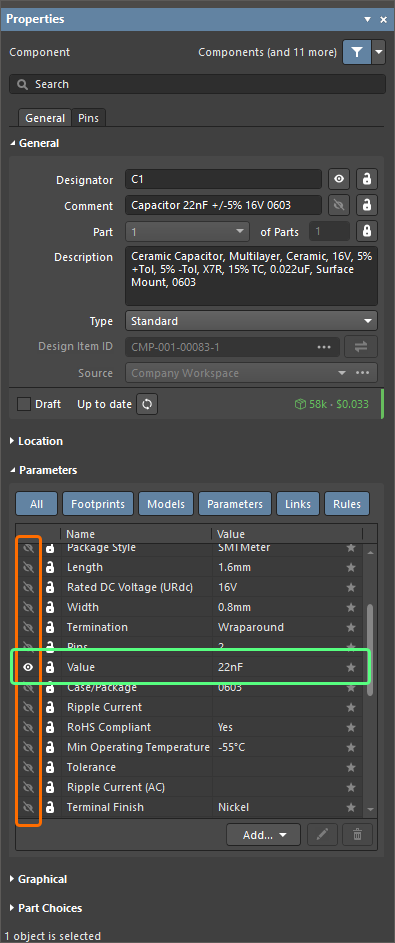
-
他のフィールドはデフォルト値のままにして、設計スペース内の一時停止ボタン( )をクリックして、コンポーネントの配置に戻ります。
)をクリックして、コンポーネントの配置に戻ります。
-
Spacebarを押して、コンポーネントを90°刻みで回転させ、正しい向きにします。
-
キャパシタをトランジスタの上に配置し、コンポーネントをクリックして配置します。

-
キャパシタC2を配置し、配置します。

-
コンポーネント配置を終了するには、右クリックまたはEscキーを押します。
抵抗の配置
-
Componentsパネルに戻り、パネルのSearchフィールドを使用してresistor 100K 5% 0805を検索します。
-
検索結果のグリッドで見つかった100K抵抗のエントリー(Resistor 100K +/-5% 0805 125 mW)を選択します。
-
DetailsペインのModels領域のでフットプリントのプレビューの下にあるMバリエーション(RESC2013X70X40ML20T20)を選択します。
-
 ボタンをクリックしてDetailsペインで操作します。
ボタンをクリックしてDetailsペインで操作します。
-
抵抗がカーソルに浮かんでいる間に、Tabキーを押してPropertiesパネルを開きます。
-
R1と入力してDesignatorフィールドに記入します。
-
パネルのShow More領域にあるShow Moreリンクをクリックし、Valueパラメータの可視性が有効になっていることを確認します。
-
他のフィールドはデフォルト値のままにして、デザインスペースの一時停止ボタン( )をクリックしてコンポーネント配置に戻ります。
)をクリックしてコンポーネント配置に戻ります。
-
Spacebarを押して、コンポーネントを90°単位で回転させ、正しい向きになるまで調整します。
-
抵抗をQ1のベースの上と左に配置し、コンポーネントをクリックして配置します。

-
次に、他の100K抵抗、R2をQ2のベースの上と右に配置します。2番目の抵抗を配置すると、指定子は自動的にインクリメントされます。

-
コンポーネント配置を終了するには、右クリックまたはEscキーを押します。
-
Componentsパネルに戻り、パネルのSearcフィールドを使用してresistor 1K 5% 0805 fixedを検索します。
-
検索結果のグリッドで見つかった1K抵抗のエントリー(Resistor 1K +/-5% 0805 500 mW)を選択します。
-
DetailsペインのModels領域でフットプリントのプレビューの下にあるMバリエーション(RESC2013X70X40ML20T20)を選択します。
-
 ボタンをクリックしてDetailsペインで操作します。
ボタンをクリックしてDetailsペインで操作します。
-
抵抗がカーソルに浮かんでいる間に、Tabキーを押してPropertiesパネルを開きます。
-
R3と入力してDesignatorフィールドに記入します。
-
パネルのParameters領域にあるShow Moreリンクをクリックし、Valueパラメータの可視性が有効になっていることを確認します。
-
他のフィールドはデフォルト値のままにして、デザインスペースの一時停止ボタン( )をクリックしてコンポーネント配置に戻ります。
)をクリックしてコンポーネント配置に戻ります。
-
Spacebarを押して、コンポーネントを90°単位で回転させ、正しい向きになるまで調整します。
-
Q1のコレクターの真上にR3を配置し、次にQ2のコレクターの真上にR4を配置します。

-
コンポーネント配置を終了するには、右クリックまたはEscキーを押します。
コネクタの配置
-
Componentsパネルに戻り、パネルのSearchフィールドを使用してconnector male straightを検索します。
-
検索結果のグリッドで見つかったコネクタのエントリーを選択します。
-
 ボタンをクリックしてDetailsペインで操作します。
ボタンをクリックしてDetailsペインで操作します。
-
抵抗がカーソルに浮かんでいる間に、Tabキーを押してPropertiesパネルを開きます。
-
P1と入力してDesignatorフィールドに記入します。
-
他のフィールドはデフォルト値のままにして、デザインスペースの一時停止ボタン( )をクリックしてコンポーネント配置に戻ります。
)をクリックしてコンポーネント配置に戻ります。
-
Spacebarを押して、コンポーネントを90°単位で回転させ、正しい向きになるまで調整します。
-
回路図上にコネクタを配置するためにクリックします。

-
コンポーネント配置を終了するには、右クリックまたはEscキーを押します。
-
Projectsパネルでそのエントリを右クリックし、コンテキストメニューからSaveを選択して、回路図ドキュメントをローカルに保存します。
回路の配線
メインページ: 回路図における回路接続の作成
配線とは、回路の様々なコンポーネント間の接続を作成するプロセスです。回路図を配線するには、回路のスケッチ( )と、以下に示されたビデオを参照してください。
)と、以下に示されたビデオを参照してください。
配線に関する注意
-
配線を開始するには、メインメニューからPlace » Wireコマンドを選択します(ショートカット:Ctrl+W)。
-
カーソル位置でワイヤをアンカーします。
-
最後のアンカーポイントを削除するにはBackspaceキーを押します。
-
コーナーの方向を切り替えるにはSpacebarを押します。これは、上に示されたビデオの終わりに向けて、コネクタが配線されている際に観察できます。
-
ワイヤ配置モードを終了するには、右クリックまたはEscキーを押します。
-
クリックしてドラッグすると、接続されたワイヤと一緒にコンポーネントをドラッグできます。Ctrl+クリックしてドラッグすると、配置されたコンポーネントを移動できます。
-
ワイヤがコンポーネントの接続点を横切るか、別のワイヤ上で終了すると、自動的にジャンクションが作成されます。
-
ピンの端を横切るワイヤは、そのピンに接続されます。
配線ツールを使用して回路を配線します。ビデオの終わりに向けて、ワイヤをドラッグする方法が見られます。
-
まず、抵抗R1の下部ピンをトランジスタQ1のベースに次の方法で配線します。メインメニューからPlace » Wireコマンドを選択するか(またはCtrl+Wショートカットを使用して)、ワイヤ配置モードに入ります。カーソルが十字線に変わります。
-
R1の下端にカーソルを合わせます。正しい位置にいると、カーソル位置に赤い接続マーカー(赤い十字)が表示されます。これは、カーソルがコンポーネント上の有効な電気接続点にあることを示しています。
-
最初のワイヤポイントをアンカーするためにクリックします。カーソルを移動すると、カーソル位置からアンカーポイントまでワイヤが伸びます。
-
Q1のベースにカーソルを合わせると、カーソルが赤い接続マーカーに変わるのを見るまで待ちます。ワイヤが間違った方向にコーナーを形成している場合は、Spacebarを押してコーナーの方向を切り替えます。
-
Q1のベースにワイヤを接続するためにクリックします。カーソルはそのワイヤから解放されます。
-
カーソルが十字線のままであり、別のワイヤを配置する準備ができていることに注意してください。配置モードを完全に終了して矢印カーソルに戻るには、右クリックまたはEscキーを押しますが、今はこれを行わないでください。
-
次に、R3の下部ピンからQ1のコレクタに配線します。R3の下部ピンにカーソルを合わせて新しいワイヤを開始するためにクリックします。カーソルを垂直に移動してQ1のコレクタの上になるまで待ち、次にワイヤセグメントを配置するためにクリックします。再び、カーソルはそのワイヤから解放され、配線モードのままで、別のワイヤを配置する準備ができています。
-
上に示されたビデオのように、残りの回路を配線します。
-
すべてのワイヤを配置し終えたら、右クリックまたはEscキーを押して配置モードを終了します。カーソルは矢印に戻ります。
ネットラベルの配置
互いに接続された各コンポーネントのピンのセットは、ネットとして参照されるようになります。たとえば、一つのネットにはQ1のベース、R1の一つのピン、C1の一つのピンが含まれます。各ネットには、そのネット内のコンポーネントのピンの一つに基づいてシステムが生成した名前が自動的に割り当てられます。
設計内の重要なネットを簡単に識別できるようにするために、名前を割り当てるネットラベルを追加できます。マルチバイブレータ回路の場合、以下に示すように、回路内の12VとGNDネットにラベルを付けます。

12VとGNDネットにネットラベルが追加され、回路図が完成しました。
-
メインメニューからPlace » Net Labelコマンドを選択します。ネットラベルがカーソルに浮かんで表示されます。
-
配置される前にネットラベルを編集するには、Tabキーを押してPropertiesパネルを開きます。
-
12VをNet Nameフィールドに入力します。

-
設計スペース内の一時停止ボタン( )をクリックしてオブジェクト配置に戻ります。
)をクリックしてオブジェクト配置に戻ります。
-
ネットラベルのホットスポット(左下隅)が回路図の最上部のワイヤに触れるように配置します。下の画像に示されているように、ネットラベルがワイヤに接続する正しい位置にあるとき、カーソルは赤い十字に変わります。十字が薄い灰色の場合、有効な接続が行われないことを意味します。
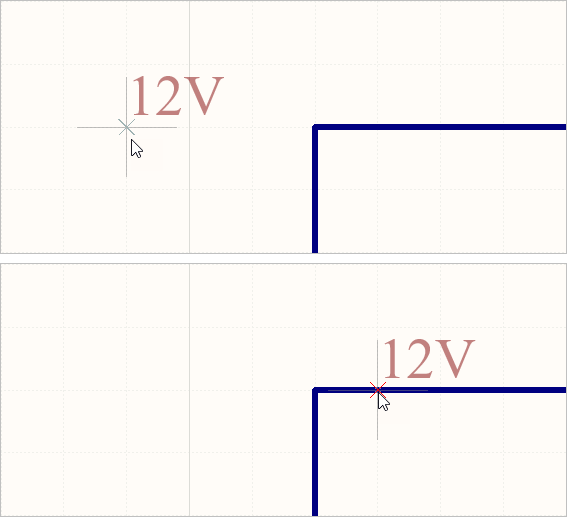
フリースペースにあるネットラベル(上の画像)とワイヤ上に配置されたネットラベル(下の画像)、赤い十字に注目してください。
-
最初のネットラベルを配置した後、ネットラベル配置モードのままです。 Tab キーを再度押して、配置する前にプロパティパネルで2番目のネットラベルを編集します。
-
GNDをNet Nameフィールドに入力します。
-
設計スペース内の一時停止ボタン( )をクリックしてオブジェクト配置に戻ります。
)をクリックしてオブジェクト配置に戻ります。
-
ネットラベルの左下が回路図の最下部のワイヤに触れるように配置します(上に示された完成した回路図のように)。右クリックまたはEscを押してネットラベル配置モードを終了します。
-
Projectsパネルでそのエントリを右クリックし、コンテキストメニューからSaveを選択して、回路図ドキュメントをローカルに保存します。
おめでとうございます! あなたはちょうど最初の回路図キャプチャを完了しました。回路図を回路基板に変換する前に、プロジェクトオプションを設定し、設計のエラーをチェックする必要があります。
プロジェクトオプションの設定
メインページ: プロジェクトオプションのアクセス、定義、および管理
プロジェクト固有の設定はProject Optionsダイアログで設定されます。プロジェクトオプションには、エラー報告設定、接続マトリックス、クラス生成設定などが含まれます。いくつかのプロジェクトオプションは以下に示し、説明されています。
❯ ❮
Javascript ID: Tutorial_Dlg_ProjectOptions_AD24
|
プロジェクトを検証するとき、Altium Designerは回路図の内容とエラー報告設定の間の論理的、電気的、およびドラフティングエラーをチェックします。Error Reportingタブは、Project Optionsダイアログで、幅広いチェックを設定するために使用されます。Report Mode設定は、違反の重大度レベルを示します。設定を変更したい場合は、変更したい違反の隣にある現在のReport Modeをクリックし、ドロップダウンリストから重大度レベルを選択します。
設計が進むにつれて、各ネットのピンのリストがメモリに組み込まれます。各ピンのタイプ(例:入力、出力、受動など)が検出され、次に各ネットがチェックされ、接続してはならないピンタイプがあるかどうかを確認します。例えば、出力ピンが別の出力ピンに接続されている場合です。Connection Matrixタブは、Project Optionsダイアログで、どのピンタイプを互いに接続できるかを設定する場所です。例えば、マトリックス図の右側のエントリを見て、Output Pinを探します。この行のマトリックスを横に読み進めて、Open Collector Pin列に到達します。彼らが交差する四角はオレンジ色で、プロジェクトが検証されるときに、回路図上の出力ピンがオープンコレクタピンに接続されているとエラー状態が生成されることを示しています。各エラータイプを別々のエラーレベルで設定できます。つまり、No ReportからFatal Errorまでです。設定を変更するには、色付きの四角をクリックします。それは4つの可能な設定を通じてサイクルします。
Class Generationタブは、Project Optionsダイアログで、設計からどのタイプのクラスが生成されるかを設定するために使用されます(ComparatorおよびECO Generationタブは、クラスがPCBに転送されるかどうかを制御するために使用されます)。
Comparatorタブは、Project Optionsダイアログで、文書を比較するときに報告されるか無視されるかの違いを設定します。詳細な制御が必要な場合は、個々の比較設定を使用してコンパレータを選択的に設定できます。
|
-
Projectsパネルでプロジェクトエントリを右クリックし、コンテキストメニューからProject Optionsコマンドを選択して、Project Optionsダイアログを開き、ダイアログのError Reportingタブを選択します。

-
エラーチェックのリストをスクロールして、それらがグループにクラスタされていることに注意してください。必要に応じて各グループを折りたたむことができます。
-
任意のチェックのReport Mode設定をクリックし、利用可能なオプションに注意してください。
-
Connection MatrixタブをProject Optionsダイアログで選択します。
-
回路にはPassive Pinのみが含まれています。行ラベルを下に見て、受動ピン行を見つけます。列ラベルを横に見て、Unconnectedを見つけます。これらのエントリが交差する四角は、回路図で受動ピンが未接続であると見つかったときのエラー状態を示しています。デフォルト設定は緑色( )で、報告が生成されないことを示しています。
)で、報告が生成されないことを示しています。
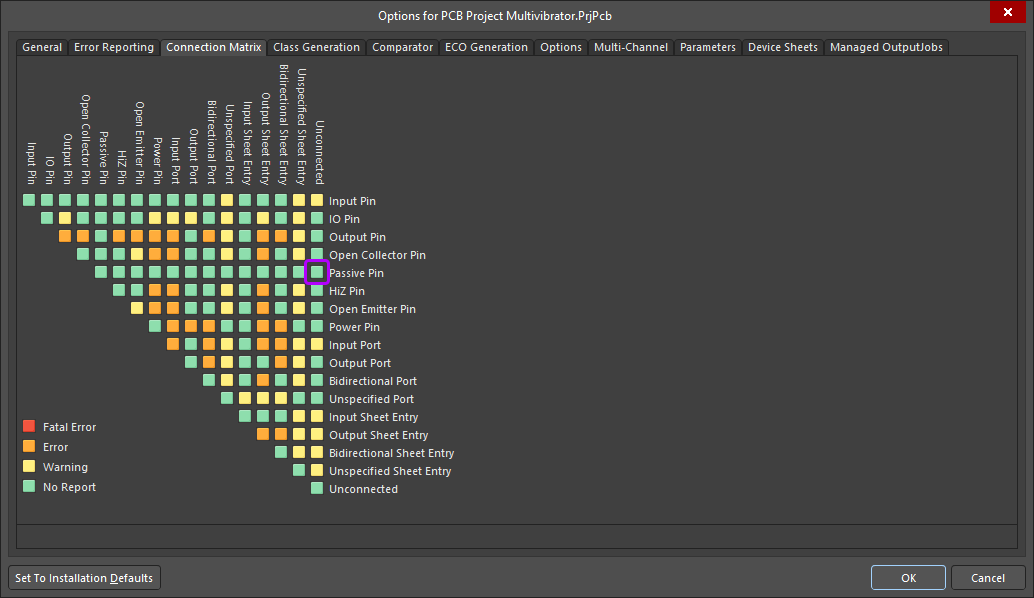
-
接続マトリックスが未接続の受動ピンを検出するようにデフォルト設定を変更します。この交差ボックスをクリックするとオレンジ色( )に変わり、プロジェクトが検証されたときに未接続の受動ピンに対してエラーが生成されるようにします。このチュートリアルで後ほど、この違反のインスタンスを意図的に作成します。
)に変わり、プロジェクトが検証されたときに未接続の受動ピンに対してエラーが生成されるようにします。このチュートリアルで後ほど、この違反のインスタンスを意図的に作成します。
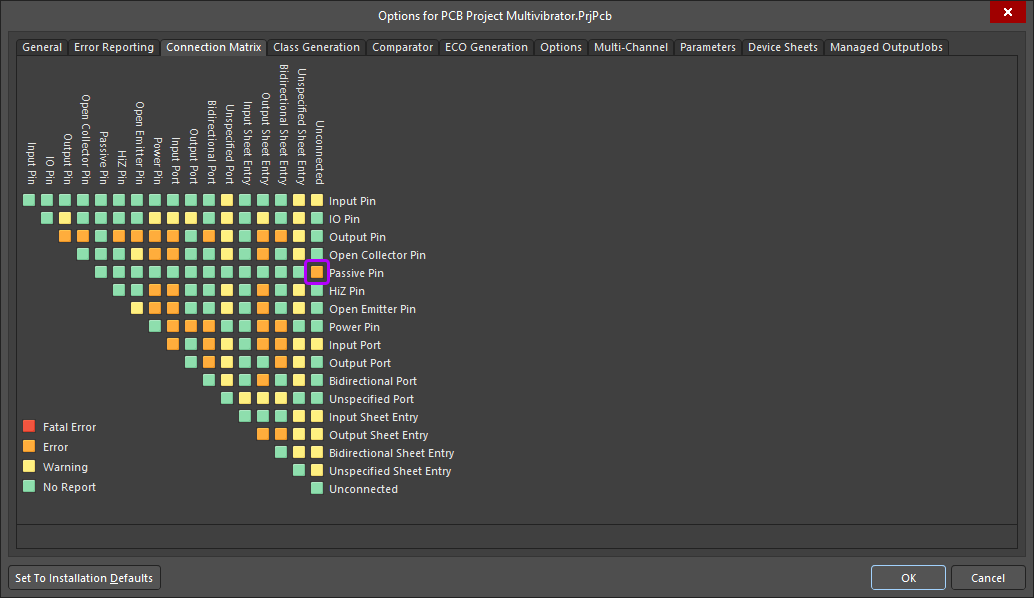
-
UnconnectedタブをProject Optionsダイアログで選択します。
-
このような単純な単一シート設計では、コンポーネントクラスを生成する必要はありません。プロジェクトの回路図ドキュメントのComponent Classesチェックボックスをオフにします。

-
OKをクリックして変更を適用し、Project Optionsダイアログを閉じます。
-
プロジェクトをローカルに保存するには、Projectsパネルでエントリを右クリックし、コンテキスト メニューからSaveを選択します。
これで、プロジェクトを検証し、エラーをチェックする準備が整いました。
プロジェクトの検証
メインページ: 設計プロジェクトの検証
プロジェクトの検証では、設計文書のドラフト作成と電気規則のエラーをチェックし、Messagesパネルにすべての警告とエラーを詳細に表示します。チェック設定をError CheckingおよびProject OptionsダイアログのConnection Matrixタブで設定したので、これで設計のチェックが可能です。
-
マルチバイブレータプロジェクトを検証するには、Projectsパネルでそのエントリを右クリックし、コンテキストメニューからValidate PCB Project Multivibrator.PrjPcb を検証を選択します。

-
すべての検証警告とエラーはMessagesパネルに表示されます。エラーが検出された場合にのみパネルが自動的に開きます(警告のみの場合は開きません)。手動で開くには、設計スペースの右下にある ボタンをクリックし、メニューからMessagesを選択します。
ボタンをクリックし、メニューからMessagesを選択します。
-
回路が正しく描かれている場合、Messagesパネルにはエラーが含まれず、Compile successful, no errors foundというメッセージのみが表示されます。エラーがある場合は、それぞれのエラーを確認しながら回路をチェックし、すべての配線と接続が正しいことを確認してください。

次に、意図的に回路にエラーを導入し、プロジェクトを再度検証します。
-
P1とQ1およびQ2のエミッタを接続するワイヤー(ネットGNDのワイヤー)の中央をクリックします。ワイヤーの各頂点に小さな四角い編集ハンドルが表示され、選択された色がワイヤーに点線として表示され、選択されていることを示します。Deleteキーを押してワイヤーを削除します。

-
プロジェクトを再度検証します(プロジェクトエントリの右クリックメニューからValidate PCB Project Multivibrator.PrjPcbを検証を選択)。Messagesパネルには、回路に未接続のピンがあることを示すエラーメッセージが表示されます。

-
メッセージパネルは上記の画像に示されているように、水平に二つの領域に分かれています。上部の領域にはすべてのメッセージがリストされ、右クリックメニューを介して保存、コピー、クロスプローブ、またはクリアが可能です。下部の領域には、パネルの上部領域で現在選択されている警告/エラーの詳細が表示されます。
-
メッセージパネルのどちらかの領域でエラーや警告をダブルクリックすると、回路図ビューが違反しているオブジェクトにパンおよびズームします。
-
違反オブジェクト(うねうねした線ではない)の上にカーソルを合わせると、違反条件を説明するメッセージが表示されます。
このチュートリアルのセクションを終了する前に、回路図の違反を修正してください。
-
削除アクションを元に戻す(Ctrl+Z)して、削除されたワイヤーを復元します。
-
違反がなくなったことを確認するために、プロジェクトを再度検証します。Messagesパネルには違反が表示されなくなります。
-
プロジェクトをワークスペースに保存します。これを行うには、Projectsパネルのプロジェクトエントリの隣にあるSave to Serverコントロールをクリックし、開いたSave to ServerダイアログのCommentフィールドに意味のあるコメントを入力します(例:Schematic is created and validated)、そしてOKボタンをクリックします。
部品表の設定
メインページ: ActiveBOMを使用したBOM管理
最終的に、設計に使用されるすべてのコンポーネントには、詳細なサプライチェーン情報が必要です。この情報を各設計コンポーネントに追加するか、Excelスプレッドシートでの後処理として追加するのではなく、設計サイクルの任意の時点でActiveBOMドキュメント(*.BomDoc)を通じて追加できます。
ActiveBOMは、接続されたワークスペースの設定で有効にされた部品プロバイダーを使用して、リアルタイムでサプライチェーンを照会します。データはリアルタイムで更新されるため、このチュートリアルで使用される部品の可用性は時間とともに変化します。利用可能なサプライヤーのリストも時間とともに変化します。これらの理由から、得られる結果は、このチュートリアルで示され、説明されている結果と異なる場合があります。
-
Projectsパネルでプロジェクトエントリを右クリックし、コンテキストメニューからAdd New to Project » ActiveBOMコマンドを選択します。新しいActiveBOMドキュメントが開き、そのエントリがプロジェクトパネルのSource Documentsエントリの下にプロジェクトにリンクされて表示されます。
-
Projectsパネル内のActiveBOMドキュメントエントリを右クリックし、プロジェクトパネルでSave Asコマンドを選択します。プロジェクトファイルと同じ場所にドキュメントを保存する準備ができたSave Asダイアログが開きます。Multivibratorという名前をFile nameフィールドに入力し、保存ボタンをクリックします。
-
ActiveBOMドキュメントを追加するとプロジェクトが変更されるため、プロジェクトエントリをProjectsパネルで右クリックしてSaveを選択し、プロジェクトをローカルに保存します。
-
設計で使用されるコンポーネントはBOMアイテムとしてリストされます。デフォルトでは、Line #というタイトルの列があります。ドキュメントの上部にある ボタンをクリックして、この列を埋めます。
ボタンをクリックして、この列を埋めます。

-
BOM 品目グリッドの右側には、BOM ステータス列が含まれていることに注意してください。ステータスアイコンの上にマウスカーソルを置くと、検出された問題に関する情報が表示されます。ステータス アイコンは、すべての BOM 項目にNo MPN rankedの違反が含まれていることを示す必要があります。これは、選択した製造元の部品番号 (MPN) をまだ確認しておらず、それぞれに問題がないことを示しています。

トランジスタには他のエラーが存在する可能性があります。これは間もなく解決されます。
-
違反タイプがNo MPN ranked以外のアイテム(つまり、トランジスタを除くすべてのアイテム)に5つ星のランクを割り当てます。これを行うには、グリッド内のBOMアイテムをクリックし、そのアイテムのサプライチェーン情報を表示するドキュメントの下部にある最も右の星をクリックします。その後、5つのBOMアイテムのうち4つのステータスが緑色に変わり、これらのアイテムがクリアされた(注文準備完了)ことを示します。
-
トランジスタアイテムを選択します。製造ライフサイクルがObsoleteである可能性があります。このアイテムには、ワークスペースライブラリ内のコンポーネントにパートチョイスを追加することで、別のMPNを追加します。 ボタンをクリックし、ドロップダウンメニューからEdit Part Choices in Libraryを選択します。
ボタンをクリックし、ドロップダウンメニューからEdit Part Choices in Libraryを選択します。

-
Edit Part Choicesダイアログが開きます。 ボタンをクリックしてAdd Part Choicesダイアログを開きます。このダイアログは、Manufacturer Part Searchパネルと同じ方法で適切な製造元部品を検索するために使用されます。
ボタンをクリックしてAdd Part Choicesダイアログを開きます。このダイアログは、Manufacturer Part Searchパネルと同じ方法で適切な製造元部品を検索するために使用されます。

-
Add Part Choicesダイアログの上部にあるSearchフィールドにBC547Cと入力してEnterを押し、検索範囲を広げます。

-
Manufacturer Part列の端にある垂直の色付きバーに注意してください。これはその部品のライフサイクル状態を示しています。理想的には、ライフサイクル状態が緑色(Volume Production)の部品を選択します。カーソルを垂直の色付きバーに合わせてライフサイクル状態を確認してください。部品にモデルが必要ないことに注意してください。なぜなら、すでに回路図上にシンボルとPCB上にフットプリントを持っているからです。
適切なライフサイクル状態と在庫がある部品(例:BC547CTFR、ON Semiconductor / Fairchildから)を選択し、OKをクリックしてこの部品を受け入れます。

-
選択した部品がリストされるEdit Part Choicesダイアログに戻ります。

OKをクリックしてダイアログを閉じ、ActiveBOMドキュメントに戻ります。
-
ドキュメントの下部には、トランジスタのための2つのMPNが表示されます。1つはコンポーネント作成時に追加された元のパートチョイスから派生したもので、もう1つはあなたがただ追加したパートチョイスから派生したものです。ランキング機能を使用して、選択した部品をこのBOMアイテムの主要な解決策として昇格させます。

-
すべてのBOMアイテムには、適切なサプライチェーンの詳細が含まれるようになりました。ActiveBOMドキュメントをローカルに保存するには、プロジェクトパネルでそのエントリを右クリックし、コンテキストメニューからSaveを選択します。
-
プロジェクトをワークスペースに保存します。これを行うには、Projectsパネルのプロジェクトエントリの隣にあるSave to Serverコントロールをクリックし、開いたSave to ServerダイアログのCommentフィールドに意味のあるコメントを入力します(例:BOM document added)、そしてOKボタンをクリックします。
-
デザインスペースの上部にあるタブを右クリックしてActiveBOMドキュメントを閉じ、コンテキストメニューからClose Multivibrator.BomDocコマンドを選択します。

回路図のキャプチャが完了しました。これで、設計制約を設定する時間です!
制約マネージャが使用できない場合は(回路図エディタのDesignメインメニューを開き、Constraint Managerコマンドを確認することで、制約マネージャが使用可能かどうかをすばやく確認できます)、PCBドキュメントの作成および構成ページに移動します。